Portfolio
Descriptive Analysis of Health Survey Data using Tableau (Dissertation Data Project Series )
Shelter Surveillance Report/Poster Presentation
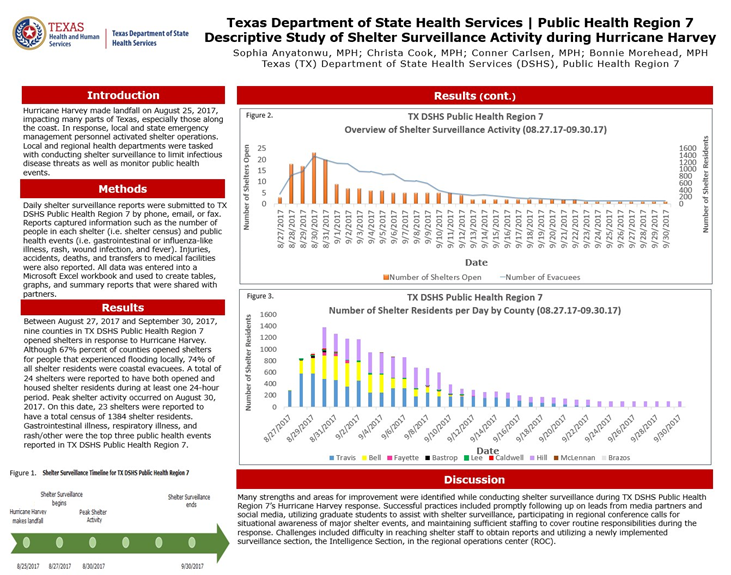
Business Case: There was a need to summarize results from our health department’s Hurricane Harvey Response in order to share best practices and inform leaders.
Time Frame: 4 months
Resources: A dynamic shelter surveillance database that I created in Excel from a static reporting form.
Assumptions: Capturing the response sooner rather than later can help leadership with gaining an overview of the response and best practices to implement in the future
Stakeholders: Texas DSHS Region 7, Texas DSHS, state of Texas, local counties
Objective: To summarize Hurricane Harvey Shelter Surveillance activity in Texas DSHS Region 7 in order to better respond to and inform future responses.
Deliverables: Poster presentation at conference and stakeholder report
Surveillance Networking Spaces Project Concept
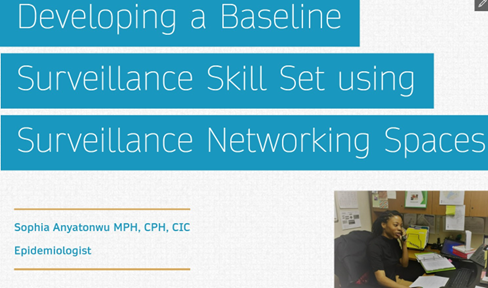
Business Case: Developing a baseline skill set across a public health agency before a disaster or public health response is needed for these organizations to maintain credibility in the community.
Time Frame: 1 year
Resources: 1) My experience creating public health surveillance databases for high-consequence public health events or conditions at the local level, 2) Public health department priorities, 3) Public health agency leadership/department heads, 4) Data analysts/surveillance staff/epidemiologists, 5) Workplace skills assessments, 6) Past public health responses
Assumptions: Maintaining legitimacy in the community is important for communicating the relevance of public health in local communities as well as for sustained funding by the public.
Stakeholders: local community members, local community leaders, agency leadership, surveillance staff
Objectives: To develop a peer leadership program with support from agency leadership that is focused on standardizing the skill set of staff that work with data/contribute to surveillance reports across the agency.
Deliverables: Online course introduction and agenda, networking presentation at an international conference, curated curriculum, peer trainer and evaluation plan
Central Texas APIC Chapter Website Development Committee
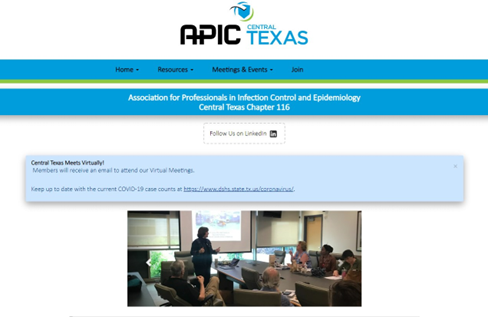
Business Case: The Chapter website was not member or user-friendly and did not reflect the growing Chapter. Chapter Leadership had been talking about fixing the website for years and had the opportunity to since funds were available.
Time Frame: 6-7 months
Resources: 1) Website developer (The Chapter paid for their membership as a form of compensation), 2) Current website, 3) Website development committee that I put together and spearheaded, 4) Website update plan that I created with input from board members and officers, 5) President of chapter, 6) President-elect of chapter (my role at the time)
Assumptions: This update is an investment in the Chapter and its members.
Stakeholders: Central Texas APIC Board, Central Texas APIC officers, Central Texas APIC members, Central Texas community members, Central Texas APIC vendors
Objectives: To have a website launched and ready to go as soon as possible
Deliverables: An updated website
Taking Learning Metrics Online for the Zambia Field Epidemiology Training Program
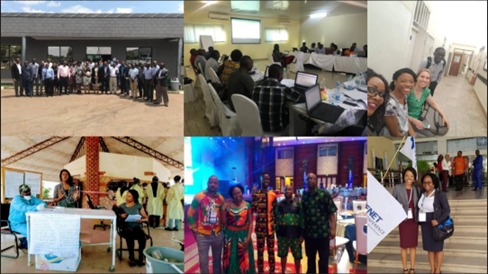
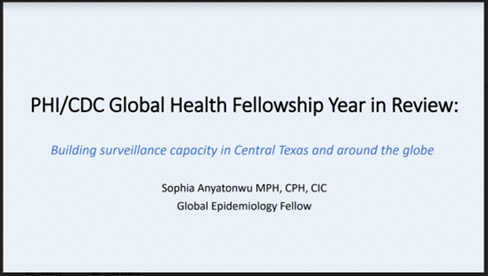
Business Case: Data was not being tracked as efficiently as it could be to measure learning outcomes of residents in the Zambia Frontline Epidemiologist Training Program (FETP).
Time Frame: 1 year
Resources: 1) Paper-based forms, 2) Time, 3) Google forms/sheets, 4) Internet/Wi-Fi, 5) Cell phones and laptops
Assumptions: Transitioning quizzes and assessments online should better help program leadership track residents’ progress as well as inform evaluation efforts that will support goals to gain accreditation for the FETP program. Paper-based forms can be a back-up in case of Wi-Fi challenges.
Stakeholders: Zambia FETP leadership and residents, Zambian government, U.S. government
Objectives: To transition the Zambia FETP learning outcomes data online using affordable resources.
Deliverables: Pilot project results from entering paper forms into online database using Google forms, preliminary launches of online forms at two frontline workshops for residents, and online forms incorporated into a program evaluation for accreditation efforts
Maternal Mortality Review Committee Evaluation
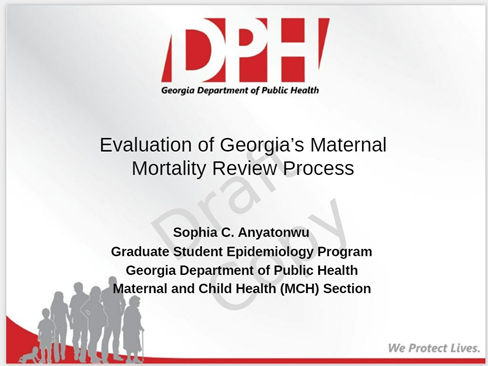
Business Case: There was a need to review the Georgia MMRC process that was established as a result of political backlash from a report which listed Georgia as the state with the worst maternal mortality rate.
Time Frame: 3 months
Resources: 1) Evaluation consultant (me), 2) Literature review, 3) Document and report review, 4) Web searches, 5) Key stakeholders/staff including maternal and child health epidemiologists at Georgia Department of Public Health, 7) Health Resources and Services Administration (HRSA) Graduate Student Epidemiology Program
Assumptions: If a process was created in order to lower the maternal mortality rate in Georgia, then we should be able to track the process and make sure that it is meeting its objectives.
Stakeholders: Georgia Department of Public Health Maternal and child health epidemiologists, HRSA, government officials in Georgia
Objectives: Conducted a systematic evaluation of the current process for identifying, reviewing, and classifying deaths that occur during or within 1 year of pregnancy in the state of Georgia.
Deliverables: Slide deck, executive summary and full report; Presentation to health department staff and leadership; Conference abstract/presentation
Central Texas APIC Long-Term Care Initiative
Business Case: There are many long-term care providers who don’t report to the health department and do not know that we can be a resource to them.
Time Frame: 6 months
Resources: I created a data collection form (both paper and online) to capture membership engagement needs for current and prospective members with input from local health department staff and Central Texas APIC leadership.
Assumptions: Being proactive about outreach is strategic for infectious disease reporting and building relationships.
Stakeholders: Central Texas APIC, local health department epidemiologists and public health nurses
Objectives: 1) To develop a questionnaire that can be implemented by local health departments 2) To use results to show areas that are complementary for long-term care and public health
Deliverables: Questionnaire/needs assessment for long-term care providers, slide deck with results from Austin Public Health
The Scrutinizer Challenge Initiative
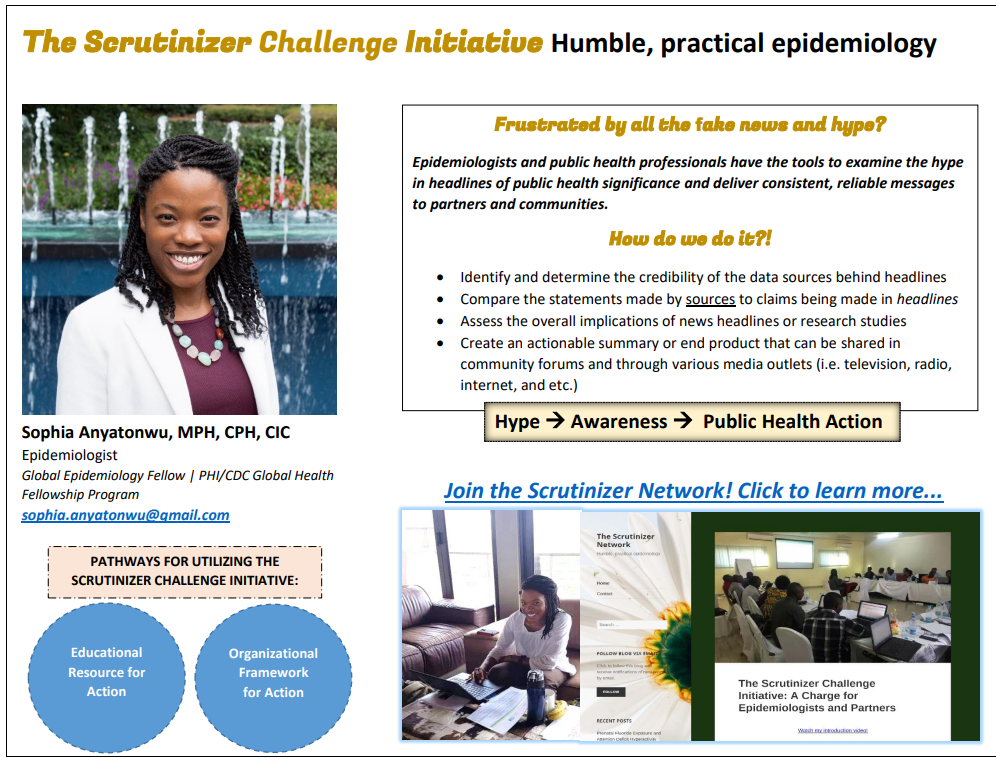
Business Case: Epidemiologists have the skills needed to be a practical resource/better serve communities and should do so.
Time Frame: 1 year
Resources: 1) MPH-trained, local epidemiologist (me), 2) literature review, 3) research protocol I created, 4) communications outlet(s), 5) organizational framework I created, 6) body of practitioners and/or researchers in professional organizations.
Assumptions: Epidemiologists have received training in their MPH programs that has prepared them to be able to critically review and analyze headlines that impact the public’s health. This means that they can help create straightforward messages and guidance for local communities.
Stakeholders: Epidemiologists, public health professionals, community organizations, local public health associations, local government
Objectives: To develop a process that incorporates the training of epidemiologists with an MPH, and is straightforward for analyzing headlines and associated research articles
Deliverables: Scrutinizer challenge process, monthly/quarterly scrutinizer challenge summaries, conference abstracts, conference presentations, preconference workshop/training, membership engagement questionnaire to test assumptions of the initiative
Texas Department of State Health Services Flu Surveillance Quality Improvement Project
Business Case: Being able to use surveillance data for action is important for maintaining the value of relationships, particularly for flu reporters and community members. Masters-level epidemiologists have minimal opportunities to apply their knowledge to evaluating surveillance systems. As a result, when the opportunity arises to make meaningful improvements they should be ready to apply their skills to making positive change.
Time Frame: 9 months
Resources: 1) Regional Influenza Surveillance Coordinator (me), 2) current flu reporting process, 3) quality improvement mindset, 4) Masters in Public Health (Epidemiology)
Assumptions: If we are collecting flu surveillance data then we should be doing something meaningful with this data (i.e., use it to better serve the community).
Stakeholders: DSHS Region 7 leadership, Central Texas communities, local and state health department flu reporters
Objectives: To improve the flu surveillance process and get better acquainted with the needs of reporters as well as the data itself.
Deliverables: Stakeholder/membership engagement needs assessments, improved flu reporting process, training videos and documents for the new process, presentation at flu surveillance conference, one-pagers that incorporate mapping software, summary of quality improvement process to share with stakeholders